arkansas
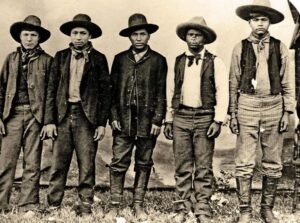 The Rufus Buck Gang was a multiracial group of African American and Native American outlaws, notorious for a series of murders, robberies, and assaults. They were a brutal bunch, and they considered anyone fair game…men, women, and children. Headed up by Rufus Buck, the gang also consisted of Lucky Davis, Maoma July, Lewis Davis, and Sam Sampson. The men had no scruples and no respect for life. Their criminal activities took place in the Indian Territory of the Arkansas-Oklahoma area from July 30, 1895, through August 4, 1896.
The Rufus Buck Gang was a multiracial group of African American and Native American outlaws, notorious for a series of murders, robberies, and assaults. They were a brutal bunch, and they considered anyone fair game…men, women, and children. Headed up by Rufus Buck, the gang also consisted of Lucky Davis, Maoma July, Lewis Davis, and Sam Sampson. The men had no scruples and no respect for life. Their criminal activities took place in the Indian Territory of the Arkansas-Oklahoma area from July 30, 1895, through August 4, 1896.
Before they started their crime spree, the gang began while staying in Okmulgee, Oklahoma, by building up a small stockpile of weapons. Then, on 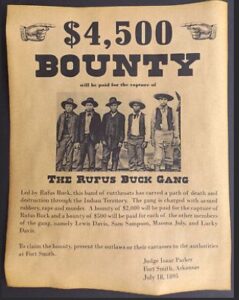 July 30, 1895, they killed Deputy US Marshal John Garrett. With the lawman out of the way, they began holding up various stores and ranches in the Fort Smith area over the next two weeks. Then, the brutality began. During one robbery, a salesman named Callahan, after being robbed, was offered a chance to escape…if he could outrun the gang. Callahan was an elderly man, and they thought an easy mark, but he successfully escaped, which angered the men, so the gang killed his assistant in frustration. At least two female victims who were raped by the gang died of their injuries.
July 30, 1895, they killed Deputy US Marshal John Garrett. With the lawman out of the way, they began holding up various stores and ranches in the Fort Smith area over the next two weeks. Then, the brutality began. During one robbery, a salesman named Callahan, after being robbed, was offered a chance to escape…if he could outrun the gang. Callahan was an elderly man, and they thought an easy mark, but he successfully escaped, which angered the men, so the gang killed his assistant in frustration. At least two female victims who were raped by the gang died of their injuries.
In all, the gang, Killed Deputy US Marshal John Garrett. Then on July 31, 1895, they came across a white man and his daughter in a wagon, the gang held the man at gunpoint and took the girl. They killed a black boy and beat Ben Callahan until they mistakenly believed he was dead, then took Callahan’s boots, money, and saddle. They robbed the country stores of West and J Norrberg at Orket, Oklahoma. They murdered two white women and a 14-year-old girl. Then, on August 4th, they raped a Mrs Hassen near Sapulpa, Oklahoma. Hassen and two of three other female victims of the gang…a Miss Ayres and an Indian girl 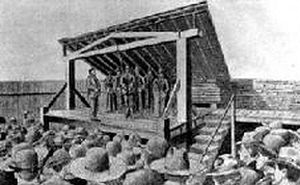 near Sapulpa, all died; and a fourth victim, Mrs Wilson recovered from her injuries. Continuing attacks on both local settlers and Creek indiscriminately, the gang was finally captured outside Muskogee by a combined force of lawmen and Indian police of the Creek Light Horse, led by Marshal S Morton Rutherford, on August 10. While the Creek Light Horse forces wanted to hold the gang for trial, the men were brought before “Hanging” Judge Isaac Parker. The judge twice sentenced them to death, the first sentence not being carried out pending an ultimately unsuccessful appeal to the Supreme Court. They were hanged on July 1, 1896 at 1pm at Fort Smith.
near Sapulpa, all died; and a fourth victim, Mrs Wilson recovered from her injuries. Continuing attacks on both local settlers and Creek indiscriminately, the gang was finally captured outside Muskogee by a combined force of lawmen and Indian police of the Creek Light Horse, led by Marshal S Morton Rutherford, on August 10. While the Creek Light Horse forces wanted to hold the gang for trial, the men were brought before “Hanging” Judge Isaac Parker. The judge twice sentenced them to death, the first sentence not being carried out pending an ultimately unsuccessful appeal to the Supreme Court. They were hanged on July 1, 1896 at 1pm at Fort Smith.

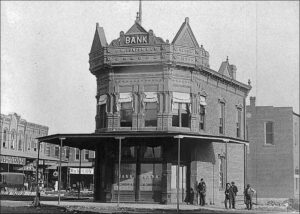 While on a trip to Tulsa, Oklahoma with my sisters, Caryl Reed and Alena Stevens, we happened to drive through the little town of Coffeyville, Kansas. We noticed a sign that said Dalton Graves. I immediate thought of the Dalton Gang and looked it up on my phone. Sure enough, Coffeyville is the site of a number of graves of the Dalton Gang. I find it strange that the gang would choose Coffeyville as the town to rob two banks at the same time, because it was in Coffeyville, that their brother Frank was buried. Frank had been a Deputy US Marshall based out of Fort Smith, Arkansas. On November 27, 1887, while involved in a gunfight with an outlaw gang near the Arkansas River, Frank Dalton was shot and killed by the outlaw, Will Towerly. It’s just odd that they would disrespect Frank’s memory in that way.
While on a trip to Tulsa, Oklahoma with my sisters, Caryl Reed and Alena Stevens, we happened to drive through the little town of Coffeyville, Kansas. We noticed a sign that said Dalton Graves. I immediate thought of the Dalton Gang and looked it up on my phone. Sure enough, Coffeyville is the site of a number of graves of the Dalton Gang. I find it strange that the gang would choose Coffeyville as the town to rob two banks at the same time, because it was in Coffeyville, that their brother Frank was buried. Frank had been a Deputy US Marshall based out of Fort Smith, Arkansas. On November 27, 1887, while involved in a gunfight with an outlaw gang near the Arkansas River, Frank Dalton was shot and killed by the outlaw, Will Towerly. It’s just odd that they would disrespect Frank’s memory in that way.
Nevertheless, it was in Coffeyville, Kansas that the Dalton Gang would make what was for all of them, except Emmett Dalton, a fatal decision. The men rode into town in the early morning hours of October 5, 1892. Their plan was to tie their horses to the hitching posts in front of the bank, however, the town had wisely removed them, meaning that one member would have to hold the horses, or they would have to tie the horses to a hitching post in another part of town. Choosing the latter, the gang tied their horses in what became known as “Death Alley” and headed for the banks.
Unfortunately for the gang, one of the townspeople recognized one of the gang members as he made his way to the bank. Immediately reporting this to the local law and the rest of the town, the people were ready for the gang when they emerged from the banks. A running gun battle ensued, and in the process, four members of the Dalton gang lost their lives. Killed were Bob Dalton, Grat Dalton, Bill Power, and Dick Broadwell. Emmett Dalton, the only surviving member of the gang was severely wounded and was not expected to live. Nevertheless, he recovered and served 14 years in jail before being pardoned.
Bob Dalton, Grat Dalton, and Bill Powers were buried in the same plot, in the Elmwood Cemetery, and for years the only marker for their grave was the metal hitching post to which they tied their horses on that fateful day. When Emmett Dalton was released, he purchased a grave marker for the three men, but the hitching post remains to this day. Also buried in Elmwood Cemetery are the four town defenders who lost their lives in that gunfight. Those lost were Lucius Baldwin, Charles Brown, Marshal CT Connelly, and George Cubine. Needless to 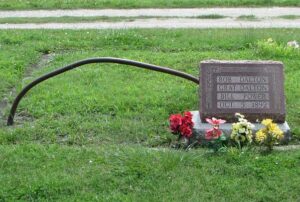
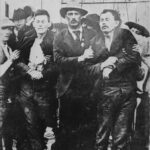 say, their graves received respectful stones from the very beginning, in order to rightly honor these brave men. Emmett Dalton moved to Southern California in 1907. He married Julia Johnson the following year, who survived him. During his California years, he capitalized on his notoriety…writing two books and doing some acting in Hollywood. Later, he sold real estate, as Southern California was developing rapidly with migrants from across the country. He died in 1937 at the age of sixty-six.
say, their graves received respectful stones from the very beginning, in order to rightly honor these brave men. Emmett Dalton moved to Southern California in 1907. He married Julia Johnson the following year, who survived him. During his California years, he capitalized on his notoriety…writing two books and doing some acting in Hollywood. Later, he sold real estate, as Southern California was developing rapidly with migrants from across the country. He died in 1937 at the age of sixty-six.
 When a river is as wide as the Mississippi, and traveling through so many states, often through flat land, the potential for flooding always exists. I know that many people who live along the Mighty Mississippi, would never consider living anywhere else. They love that old river, and having been there myself, I can certainly understand why. The river views are beautiful. Still, the yearly potential for flooding is something that might put many people off, when it comes to living on the shores of that river. Of course, people can get flood insurance, and indeed, most banks would require it for properties along that river, but the possessions lost in floods, not to mention the time it takes to rebuild the homes, and especially the lives lost in floods, make living on the shores of the Mississippi something that I would probably not decide to do.
When a river is as wide as the Mississippi, and traveling through so many states, often through flat land, the potential for flooding always exists. I know that many people who live along the Mighty Mississippi, would never consider living anywhere else. They love that old river, and having been there myself, I can certainly understand why. The river views are beautiful. Still, the yearly potential for flooding is something that might put many people off, when it comes to living on the shores of that river. Of course, people can get flood insurance, and indeed, most banks would require it for properties along that river, but the possessions lost in floods, not to mention the time it takes to rebuild the homes, and especially the lives lost in floods, make living on the shores of the Mississippi something that I would probably not decide to do.
The Great Mississippi Flood of 1927 was the most destructive river flood in the history of the United States,  with 27,000 square miles inundated up to a depth of 30 feet. To try to prevent future floods, the federal government built the world’s longest system of levees and floodways. Of the more than 630,000 people affected by the flood, 94% lived in the states of Arkansas, Mississippi, and Louisiana, most in the Mississippi Delta. By August 1927, the flood subsided. Hundreds of thousands of people had been made homeless and displaced…properties, livestock and crops were destroyed. Some people left the area, because they did not have the money, or the stomach for living in an area where their homes could so easily be wiped out. Still, the draw of the beautiful Mississippi kept many people there, determined to rebuild their lives. Of course, the flood didn’t only affect the people living along the Mississippi. Lost crops affected many people in the United States. It was a disaster of epic proportions.
with 27,000 square miles inundated up to a depth of 30 feet. To try to prevent future floods, the federal government built the world’s longest system of levees and floodways. Of the more than 630,000 people affected by the flood, 94% lived in the states of Arkansas, Mississippi, and Louisiana, most in the Mississippi Delta. By August 1927, the flood subsided. Hundreds of thousands of people had been made homeless and displaced…properties, livestock and crops were destroyed. Some people left the area, because they did not have the money, or the stomach for living in an area where their homes could so easily be wiped out. Still, the draw of the beautiful Mississippi kept many people there, determined to rebuild their lives. Of course, the flood didn’t only affect the people living along the Mississippi. Lost crops affected many people in the United States. It was a disaster of epic proportions.
Then came the floods of the Mississippi and Missouri rivers in 1993, also known as the Great Flood of 1993. This is one that many of us alive today remember, mostly because we were old enough to remember, but also because the television and newspapers were filled with the stories of destruction. The flood was among the most costly and devastating to ever occur in the United States, with $15 billion in damages. The damage area  was more than 745 miles in length and 435 miles in width, totaling about 320,000 square miles. Within this zone, the flooded area totaled around 30,000 square miles and was the worst such US disaster since the Great Mississippi Flood of 1927, as far as duration, area flooded, persons displaced, crop and property damage, and number of record river levels. In some ways, the 1993 flood even surpassed the 1927 flood, which was, at the time, the largest flood ever recorded on the Mississippi River. The effects were felt by people all over the United States because of crops lost, the rise in the cost of building materials, and of course, insurance rates as a result of increased building material prices. Floods are nearly impossible to prevent, and for some people they are considered a risk they are willing to take, but for me, I think I’ll stick to places where the chance of a flood hitting my home is almost nil. On October 7, 1993, the Great Flood of 1993 came to an end as the Mississippi River finally started to recede, 103 days after the flooding began.
was more than 745 miles in length and 435 miles in width, totaling about 320,000 square miles. Within this zone, the flooded area totaled around 30,000 square miles and was the worst such US disaster since the Great Mississippi Flood of 1927, as far as duration, area flooded, persons displaced, crop and property damage, and number of record river levels. In some ways, the 1993 flood even surpassed the 1927 flood, which was, at the time, the largest flood ever recorded on the Mississippi River. The effects were felt by people all over the United States because of crops lost, the rise in the cost of building materials, and of course, insurance rates as a result of increased building material prices. Floods are nearly impossible to prevent, and for some people they are considered a risk they are willing to take, but for me, I think I’ll stick to places where the chance of a flood hitting my home is almost nil. On October 7, 1993, the Great Flood of 1993 came to an end as the Mississippi River finally started to recede, 103 days after the flooding began.
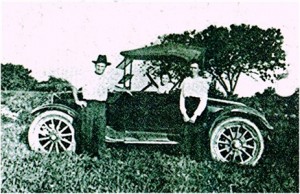 During the early years of my grandparents marriage, they lived in several places, as many people do. They spent time in Lisbon, North Dakota, and several areas of Minnesota, including Loman, Minnesota, where they had a homestead. My Aunt Laura was born in International Falls, Minnesota, which is 21 miles from Loman. These days, that is a 24 minute drive, but back then it was quite a bit more, especially since not everyone owned a car in those days. In 1918, 1 in 13 families owned a car. Then by 1929, 4 out of 5 families owned a car. A lot has changed in the years since then. Most families have at least 2 vehicles. Nevertheless, at the time my Aunt Laura was born in 1912, cars, or motor buggies as they were called, were a novelty item owned by the wealthy. That said, I would expect that my grandparents were living in International Falls at the time of my aunt’s birth, and then moved to Loman, Minnesota after that time.
During the early years of my grandparents marriage, they lived in several places, as many people do. They spent time in Lisbon, North Dakota, and several areas of Minnesota, including Loman, Minnesota, where they had a homestead. My Aunt Laura was born in International Falls, Minnesota, which is 21 miles from Loman. These days, that is a 24 minute drive, but back then it was quite a bit more, especially since not everyone owned a car in those days. In 1918, 1 in 13 families owned a car. Then by 1929, 4 out of 5 families owned a car. A lot has changed in the years since then. Most families have at least 2 vehicles. Nevertheless, at the time my Aunt Laura was born in 1912, cars, or motor buggies as they were called, were a novelty item owned by the wealthy. That said, I would expect that my grandparents were living in International Falls at the time of my aunt’s birth, and then moved to Loman, Minnesota after that time.
At some point in the year 1918, my grandfather and grandmother decided to leave the life they had built in Minnesota, spread their wings, and head south to look for greener pastures, so to speak. They had gone as far as Kansas City, presumably by train, where they bought what I’m sure was their first automobile, and headed off to Mena, Arkansas. I’m not sure how long they were in Mena, Arkansas, but eventually they ended up in Ranger, Texas, where it would appear that he might have worked in the oil fields for a time.
I can imagine how exciting this trip must have been for my Aunt Laura, who was 7 years old at the time. Not only was she going on a whole new adventure, to a whole new place, but she was going the family’s first automobile. When you are used to going places in a horse drawn buggy this new mode of travel must have been very exciting. It had speed without the horses, and better control. She could feel the wind in her hair as they flew down the road. It was a huge new adventure, a fast paced adventure, for a girl who was used to life in a slow paced world.

I’m not sure just how long they lived in Texas, but I do know that by the time my Uncle Bill was born in 1922, the family was back in the north, living in Superior, Wisconsin. Maybe they didn’t like the heat or maybe they missed the Great Lakes region in general. I don’t know why for sure, but I do know that except for a few short years, my grandparents would live out their lives in Superior, Wisconsin. Aunt Laura, who didn’t like the cold much would spread her wings again later in her life and head out west, finally settling in Oregon, where she felt most at home.

